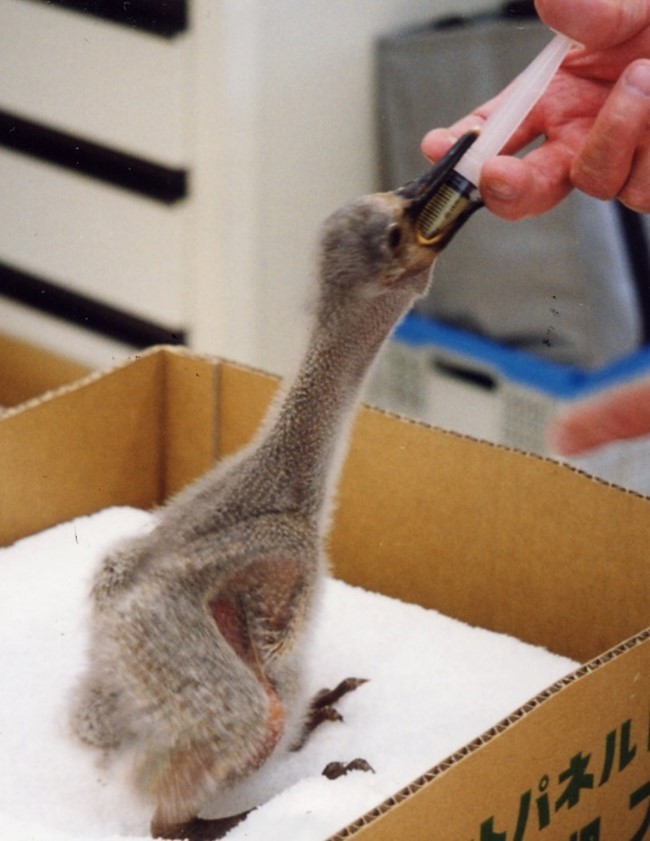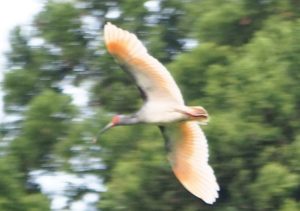Contribution of Zoo on the Conservation of Toki (Nipponia nippon)
Formerly Ueno Zoological Gardens
Kazuo Kobayashi
Ⅰ. Status of Japanese crested ibis
Toki, the Japanese crested ibis, known by its scientific name Nipponia nippon, can be considered to be a symbol of Japan’s efforts in the conservation of rare wildlife. Despite having a habitat that spanned the entire country up to the Edo period, overhunting and the modification of their habitats by humans from the Meiji period onwards resulted in sharp decreases in their numbers. Once thought to be extinct, they were confirmed to be alive in Sado in 1926, and received the designations of a natural monument in 1934, a special natural monument in 1952, and an internationally protected bird in 1960.
In 1967, the Japanese crested ibis conservation center was established in Sado, where captive breeding efforts were initiated. In 1981, the last remaining five birds in the wild were caught and housed but unfortunately could not be bred, and with the death of the last individual “Kin” in 2003, the Japanese crested ibis became extinct in Japan.
The Japanese crested ibises that are currently being bred and reintroduced in captivity are Chinese individuals and their descendants, including ♂ You-You and ♀ Yan-Yan, which were given to Japan by China in 1999. Following the hatching of Yu-Yu under public attention in May 1999, the captive breeding project successfully increased the number of individuals, and the first release of birds was conducted in September 2008. The bird release project has subsequently continued, being conducted 23 times to date (September 2020) while implementing many innovations in the release time, location, and method, and a total of 398 individuals that were bred in captivity have been released.
Nests of the released birds were observed in 2010, the first successful breeding in the wild occurred in 2012, and these birds’ chicks (the generation that were the grandchildren of the released birds that were previously mentioned) were born in 2014.
Distributed breeding has also been promoted since 2007 as a measure against infectious diseases, and the species has been bred in four facilities in Honshu, including Tama Zoological Park (Hino City, Tokyo) and Ishikawa Zoo (Nomi City, Ishikawa Prefecture). Currently, approximately 200 Japanese crested ibis individuals across seven facilities in Sado Island and Honshu are being bred as captive populations in order to support their return to the wild.
Ⅱ. Initiatives in zoos
As the situation of the Japanese crested ibis became more severe, breeding officials in the Tokyo Metropolitan Zoo organized the Japanese crested ibis Conservation Executive Committee in 1968 and systematically began the development of artificial feed and breeding research through the breeding of closely related species such as the black-headed ibis (Threskiornis melanocephalus) and scarlet ibis (Eudocimus ruber). Simultaneously, there was a cooperative system that involved actions such as regular inspections of individuals that were protected and bred in Sado.
Development of artificial feed:
In 1965, a protected individual died due to parasitism from freshwater fish in its bait, and organic mercury was detected in its body; therefore, the development of safe and uncontaminated bait became an urgent issue. Development of artificial feed for Japanese crested ibises was advanced in Ueno Zoo with repeated feeding tests with similar species, while referencing the artificial feed for the northern bald ibis (Geronticus eremita) that was developed in Basel Zoo in Switzerland. This artificial feed for Japanese crested ibises consisted of minced meat that was a mixture of horse meat, carrots, boiled eggs, and a specialized compound feed, which was then frozen and stored. Pellets for Japanese crested ibises that had good storage stability were subsequently developed, and water-resistant effervescent pellets that are suitable for birds that feed near the water were also being developed.
Artificial breeding:
Efforts were also made for the development of artificial hatching and brooding technology, which is important for captive breeding. In 1969, a black-headed ibis that was kept captive with artificial feed successfully spawned, and its artificial hatching and brooding were successful, which became the first example of the breeding of ibises in Japan. Continued innovation afterward showed that setting a temperature of 37.2–37.6 °C in a three-dimensional incubator and manually turning an egg over and cooling twice a day in addition to automated egg turning by the incubator were effective for artificial hatching, and keeping the reduction in egg weight during the incubation period constant was important.
When artificial brooding of a hatched chick is done by humans, the food type and feeding method become major issues. Various methods were attempted, but currently, a syringe is used to feed them a liquefied brooding feed that mixes in artificial feed for Japanese crested ibises and pet milk as an initial feed (Fig. 1). Surprisingly, although the ibis is a carnivore, it was found that mixing in Japanese mustard spinach with the brooding feed gave good results. Care must be given to aspiration and indigestion when feeding the chicks.

Fig. 1. Feeding using a syringe
(Provided by Sado Japanese Crested Ibis Conservation Center)
Follow-up investigations after bird release: Attaching a transmitter to the bird is important for follow-up investigations after bird release, and installation tests on captive individuals, including on similar species, were also conducted in order to investigate safe attachment methods and the effects of such attachment on breeding (Fig. 2).
The results that were obtained through such captivity of similar species in zoos have been reflected in the captive breeding and release of Japanese crested ibises.
These results were also effective in the preservation of the black-faced spoonbill (Platalea minor), which is a similar species that is also rare.

Fig. 2. Transmitter installation in similar species (black-headed ibis)
Ⅲ. Status of individuals re-introduced into the wild
Since the first bird release in 2008, 23 bird releases have been conducted in total. The first successful breeding occurred in the wild in 36 years in 2012 and breeding between two individuals that bred in the wild in 2016 was successful, and the number of individuals in the wild is increasing. In November 2020, over 450 Japanese crested ibises lived in Sado Island, which exceeded the “Road Map of the Re-introduction of the Japanese crested ibis in the Wild 2020” target of “establishing 220 Japanese crested ibises on Sado Island by around 2020”. There are more Japanese crested ibises that are established on the island, and there have been more sightings of them flying out in the wild (Fig. 3).

Fig. 3. Flight of wild individuals (photograph taken on May 14, 2018)
Ⅳ. Future issues
The Japanese crested ibis Protection Project has ushered in a new stage with the wild breeding of released individual birds, and the release of birds outside of Sado Island has been considered. Important tasks for zoos include further improving breeding techniques and applying the obtained knowledge to contribute to wild re-introduction projects, and maintaining healthy captive populations as an insurance population.
The Japanese crested ibis has been exhibited in the Sado City Japanese crested ibis Interaction Facility that was newly established in Sado City in 2013, and in Ishikawa Zoo in Ishikawa Prefecture, which is the last habitat of the Japanese crested ibis in Honshu, in 2016. Another important task for zoos is not only fulfilling the role of maintaining captive populations but also communicating information regarding the Japanese crested ibis and its protection to even more people through the exhibition of captive individuals.
https://www.env.go.jp/nature/kisho/wildlifecenter/sado-toki.html
https://www.pref.niigata.lg.jp/sec/toki/

